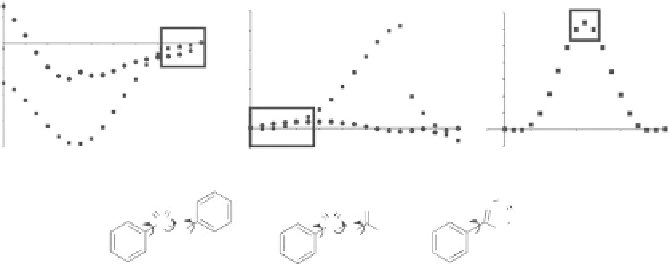Biomedical Engineering Reference
In-Depth Information
a
b
c
1
1
1
-2
q
2
q
3
q
60.0
10
50.0
40.0
30.0
20.0
10.0
0.0
-10.0
0
20
40
60
80
100
120
140
160
180
-10
-20
-30
20
40
60
80
100
120
140
160
180
-20
30
80
130
180
-40
Dihedral Angle (degrees)
Dihedral Angle (degrees)
Dihedral Angle (degrees)
d
N
N
N
O
O
S
O
q
3
O
q
3
q
q
1
O
S
q
1
H
H
N
C
q
2
q
2
H
Fig. 9 Energy diagrams calculated at the HF/6-31+G* level of theory when driving key dihedral
angles from 0
to 180
for simplified fragments of aryl (
square
) and acyl (
circle
) sulfonamides
(a, b) and for a simplified tetrazole fragment (c). (d) Labeling of key dihedral angles studied
computationally. The approximate angles required to fully engage a central guest in a fourfold
symmetrical manner are highlighted with
boxes
Focusing on the dihedral for rotation about the sulfonamide S-N bond, (
y
2
; Fig.
9a
)
and the amide/aniline dihedrals that define rotation about the neighboring N-C
bonds (
y
3
; Fig.
9b
) provides a different picture. Computational analysis revealed
that these functional groups also have preference for co-planarity with their aryl
neighbors. An analysis similar to that done for the tetrazole shows that both
compounds pay little energy in order for
y
3
to adopt a good binding geometry.
When examining
y
2
however, the acyl sulfonamide fragment pays a much higher
penalty to orient itself toward the guest than the aryl sulfonamide. These lessons
inform on sulfonamide recognition in general, as they can also explain the failure of
the Crabtree bis-sulfonamide 7. Clearly, the chosen scaffold was not ideal for
maximum host-guest binding and within the right structural context, the rigid
acyl sulfonamides have potential to bind anions with more potency.
Tetrazoles are the most highly acidic of these isosteres, and should be the best
hydrogen bonders of anions. Their utility as anion recognition elements has been
demonstrated in a variety of contexts that are informed on by considerations of host
shape and electronics. A tripodal receptor bearing three tetrazoles (15) was com-
pared to a carboxylic acid analog (14)[
52
]. Binding studies showed that the
tetrazole-functionalized host bound halides up to six orders of magnitude more
strongly than did its carboxyl functionalized counterpart despite their nearly identi-
cal acidities. Again, the apparent similarity covers up major differences in shape
and stereoelectronics that drive molecular recognition. While the acidic OH and
acidic NH groups in 14 and 15 are arrayed in nearly identical positions in three-
dimensional space, the OH groups are directed outward and away from the guest
because of a carboxylic acid's strong preference for a
syn
OH conformation. On the
contrary, the tetrazole's NH (which prefers strongly to exist as the 1H-tetrazole
tautomer in polar solutions) is oriented such that all three host NHs can bind the
guest simultaneously. The impact of these stereoelectronic effects all cooperating in

Search WWH ::

Custom Search